Research on Joint Operation of Flood Diversion and Storage Measures: A Case Study of Poyang Lake
Abstract
1. Introduction
2. Materials and Methods
2.1. Study Area
2.2. Data and Analysis
2.2.1. Current Status of SR Polders in the Poyang Lake
2.2.2. Physical Model Testing of the Kangshan Flood Diversion Sluice
2.3. Research Method
2.3.1. Methods for Flood Diversion Simulation of SR Polders
2.3.2. Methods for Flood Diversion Simulation of KS Detention
2.3.3. Fuzzy Optimization Methods for Joint Flood Diversion Operation Schemes of Flood Diversion and Storage Measures
- (1)
- Calculating the relative superiority degree matrix of quantitative targets
- (2)
- Determining the weights of quantitative targets
- (3)
- Solving the optimal relative membership degree matrix
- (4)
- Selecting the optimal flood control operation scheme.
2.3.4. Design of Flood Control Schemes and Calculation of Target Eigenvalues
- (1)
- Design of Flood Control Schemes
- (2)
- Calculation of Target Eigenvalues
- (a)
- WL Reduction (ΔH)
- (b)
- EL Duration (T)
- (c)
- FD Volume (V)
3. Results
3.1. Flood Diversion Simulation of Flood Diversion and Storage Measures Under Different Schemes
3.1.1. Analysis of SR Polders Flood Diversion Simulation
- (1)
- The rise in the OWL of the SR Polders has caused some Polders to fail to meet the flood diversion conditions during the flood diversion period, resulting in a decrease in the total flood volume. The total duration of the 1998 flood in the Poyang Lake area was 480 h (20 days), and the maximum diversion discharge for schemes A, B, and C were 4498 m3/s, 5392 m3/s, and 5358 m3/s, respectively. The total flood diversion volume was 2292.55 million m3, 2287.76 million m3, and 2287.13 million m3, respectively.
- (2)
- Raising the OWL of SR Polders-I has led to an increase in the maximum flood diversion discharge, but the main flood diversion period remains basically unchanged. Compared with scheme B, scheme A has increased the OWL of SR Polders-I by 1.0 m, while the OWL of SR Polders-II remains unchanged. The maximum diversion discharge of scheme B exceeds that of scheme A by 894 m3/s. Meanwhile, the main flood diversion periods for both are from 26 July to 29 July, during which the diversion volume accounts for 46.19% and 47.26% of the total flood volume, respectively. Raise the OWL of SR Polders-II, and the maximum flood diversion discharge remains basically unchanged, but the main flood diversion period is relatively lagging. Compared with scheme C, the OWL of SR Polders-I remains basically unchanged, with a difference of 0.15 m, while the OWL of SR Polders-II increases by 0.37 m. However, the maximum diversion discharge of the two only differs by 34 m3/s. At the same time, the main diversion period is from 27 July to 30 July, during which the diversion volume accounts for 48.53% of the total diversion volume.
3.1.2. Analysis of KS Detention Flood Diversion Simulation
- (1)
- In the early stage of flood diversion, due to the small change in water level at Kangshan Station during the diversion periods of scheme I and scheme III, with a variation of less than 0.04 m, the flood diversion discharge remained basically unchanged. During the flood diversion period of scheme II, the water level at Kangshan Station rose from 19.74 m to 20.19 m, an increase of 0.45 m, and its flood diversion discharge showed a gradual upward trend. In the later stage of flood diversion, due to the rise in downstream water level, the flow pattern gradually varies from free flow to submerged flow under the three schemes, and its discharge capacity gradually decreases.
- (2)
- Higher flood diversion levels correspond to greater discharge capacities. Comparing schemes I, II, and III, when the flood diversion levels are 20.52 m, 20.19 m, and 18.64 m, the corresponding diversion discharges are 10,193 m3/s, 9411 m3/s, and 6062 m3/s, respectively. In the early stage of flood diversion, the duration of flood diversion under each scheme is approximately linearly increasing with the cumulative flood diversion volume, and the higher the flood diversion water level, the more flood diversion volume will be in the same period; In the later stage of flood diversion, as the downstream water level gradually rises, the upward trend of flood volume gradually slows down. After about 43 h of flood diversion in scheme I, the flood storage capacity of the KS Detention approaches its limit which is to store 2.07 billion m3 of floods.
3.2. Fuzzy Optimization for Joint Flood Diversion Operation Scheme of Flood Diversion and Storage Measures
3.2.1. Calculation of the RSDM of Quantitative Targets
- (1)
- Raising the OWL of SR Polders, due to the observed water level outside the Polder being lower than OWL, some Polders have not been used, resulting in a smaller FD Volume. The total flood volume of scheme 1 exceeds that of scheme 4 and scheme 7 by 10,479 and 105.42 million m3, respectively. Compared with scheme 4, scheme 7 has a similar total flood volume, with a reduction of 630,000 m3. After comparative analysis, the main reason is the insufficient flood diversion of Lixin Polder and Longtan Polder belonging to SR Polders-II and Zhangshan Polder belonging to SR Polders-I.
- (2)
- Raising the OWL of SR Polders will reduce EL Duration. Among them, scheme 4 and scheme 7 reduced the time by 3 h and 15 h, respectively, compared to scheme 1; scheme 5 and scheme 8 reduced the time by 2 h and 6 h, respectively, compared to scheme 2; and scheme 6 and scheme 9 reduced the time by 4 h and 12 h, respectively, compared to scheme 3.
- (3)
- When the OWL of the KS Detention is the same, the WL reduction in different schemes are relatively close, and scheme 4 has the best flood diversion effect. Comparing the different schemes, such as scheme 1 and scheme 4 or scheme 2 and scheme 5, it can be seen that the OWL of SR Polders-I is relatively low.
3.2.2. Determination of the Weight of Quantitative Targets
3.2.3. Solution of the ORMDM
3.2.4. Optimal Selection of Flood Control Schemes
- (1)
- The higher the OWL of KS detention, the better the scheme. Comparing schemes 1, 2, and 3, it can be seen that the OWL of the KS detention is scheme 1 > scheme 2 > scheme 3. The superiority of schemes is scheme 1 > scheme 2 > scheme 3.
- (2)
- The higher the OWL of SR Polders-I, the better the scheme. Comparing scheme 1 and scheme 4, it can be seen that the OWL of SR Polders-I is scheme 4 > scheme 1, and the superiority of schemes is scheme 4 > scheme 1.
- (3)
- When the OWL of KS detention exceeds 21.68 m, raising the OWL of SR Polders-II has a limited effect on optimizing the scheme. The of scheme 8 is only 0.002 smaller than scheme 5. When the OWL is below 21.68 m, increasing the OWL significantly enhances the superiority of the scheme. Comparing scheme 6 with scheme 9, it can be seen that the of scheme 9 is 0.388 smaller than that of scheme 6.
- (4)
- According to the principle of the representing the optimal scheme, the optimal joint flood diversion strategy for Poyang Lake involves operating SR Polders-I at a Hukou water level of 21.65 m, operating SR Polders-I at a Hukou water level of 22.05 m, and operating the KS Detention at a Hukou water level of 22.50 m.
4. Discussion
- (1)
- A comprehensive approach to flood control through the strategic deployment of FDSM, coupled with the meticulous timing of flood diversion, is imperative to safeguard the flood control security of lakeside areas. The current water levels for operating the SR Polders in Poyang Lake are deemed lower. Building upon the work of Fu Chun [17] and Wen Tianfu [18], who employed fuzzy optimization theory to identify the optimal operation strategy for SR Polders, a consensus emerges that an appropriate raising of the OWL for Polders is justified. Our research corroborates this finding. As delineated in Table 7, a comparative analysis of schemes 1, 4, and 7 reveals that, under identical conditions, an appropriate raising of the OWL for SR Polders-I correlates positively with the superiority of the scheme. Notably, basing our investigation into the optimized flood control operation of SR Polders, we conducted a nuanced analysis of the OWL for joint flood diversion involving SR Polders and the KS Detention. The results underscore a direct correlation; as the OWL for the KS Detention incrementally decreases across schemes 1, 2, and 3, the superiority of the respective schemes progressively diminishes, highlighting a positive correlation between the OWL of the KS Detention and the superiority of schemes.
- (2)
- As an integral component of flood control engineering systems, FDSM such as SR Polders and FS Detentions play a vital role in alleviating the flood control pressures on rivers and lakes, as well as safeguarding people’s lives and property. It is of paramount importance to enhance the construction of flood control engineering systems and implement effective management and operational mechanisms. Since Jiangxi Province initiated the embankment area project of “leveling embankments for flood diversion and returning farmland to lakes” in 2003, many flood diversion facilities have, over the years of operation, suffered from aging, disrepair, or partial damage. The absence of a routine operation and management mechanism for Polders has prevented timely maintenance, leading to a diminished actual flood diversion capacity. In recent years, to effectively bolster the overall flood control capabilities of lakeside areas, Jiangxi Province issued the “Overall Plan for the Safety of Poyang Lake and the Well-being of Its People” in 2021, which mandates the coordinated implementation of embankment reinforcement to eliminate hazards and upgrade quality, strengthening the capacity for flood diversion and storage, and forming a scientific and rational spatial layout of flood storage and detention areas to achieve modernization in water governance systems and capabilities. In May 2023, the Jiangxi Provincial Water Resources Department progressively advanced construction projects and the reinforcement and improvement of flood inlet facilities for the Kangshan, Zhuhu, Huanghu, and Fangzhouxietang FS Detentions. The research findings presented in this paper provide technical methodologies and support for the optimization and scheduling of joint flood diversion operations across multiple FDSM, offering promising application prospects.
- (3)
- Poyang Lake in China is a large plain lake, and there are many lakes in the world that also belong to this type, such as Amazon floodplain lakes [30], Tonle Sap Lake in Southeast Asia [31], and Winnipeg Lake in North America [32]. Due to their unique geographical features, these lakes are unable to construct water conservancy hubs to effectively regulate floods, resulting in relatively limited flood control measures. Therefore, the construction of flood diversion and storage areas, including polders and flood storage and detention areas, has become an important measure to make up for this deficiency. The research on flood diversion of polders and flood storage and detention areas conducted in this paper not only has important guiding significance for flood control management of lakes with similar characteristics, but also provides useful references for the joint operation of flood diversion and storage areas in other regions around the world.
- (4)
- The limitations of this paper and potential research directions in the future are as follows. (a) This study investigated the joint operation of flood diversion with the KS Detention at operation water levels of 22.50 m, 21.68 m, and 20.50 m, alongside SR Polders, through the establishment of nine distinct schemes. Schemes involving water levels higher than 22.50 m were not considered. (b) With the gradual escalation of environmental protection awareness, it has become imperative to incorporate ecological benefits as a flood control target in the optimization of flood management. (c) Based on the constructed hydraulic model for SR Polders and hydrodynamic model for KS Detention, an innovative joint flood diversion simulation system for the SR Polders and FS Detentions of Poyang Lake, integrating big data analysis and artificial intelligence technology, is expected to be developed. The system will utilize the hydrological variables provided by the flood forecasting system as the model boundary conditions and formulate multiple schemes to simulate the actual application of flood diversion measures. Subsequently, through the powerful analytical capabilities of artificial intelligence technology, the simulation results of each scheme will be deeply mined and compared using big data, providing solid data support and intelligent assistance for scientific decision-making and optimization scheduling.
5. Conclusions
- (1)
- Altering the operation criteria for FDSM influences both the maximum diversion discharge and the timing of the main diversion period. For the SR Polders, under the current flood control scheme, raising the OWL of SR Polders-I by 1.0 m increases the maximum diversion discharge by 894 m3/s, but the main flood diversion period remains basically unchanged, from 26 July to 29 July. Additionally, raising the OWL of SR Polders-II by 0.37 m delays the main diversion period by one day, shifting it from 27 July to 30 July, but the maximum diversion discharge remains basically unchanged. For the KS Detention, higher flood diversion levels correspond to greater discharge capacities. Specifically, when the flood diversion levels are 20.52 m, 20.19 m, and 18.64 m, the corresponding diversion discharges are 10,193 m3/s, 9411 m3/s, and 6062 m3/s, respectively.
- (2)
- Establishing scientifically reasonable operation criteria is a crucial aspect of optimal flood control operation for FDSM. A set of operation criteria that not only meet the requirements of flood control safety but also take into account economic and social development is of great significance for maximizing the benefits of flood control and disaster reduction. Building on the prior research on SR Polders conducted by other scholars, this study further analyzed using fuzzy optimization theory and determined that the optimal joint flood diversion operational scheme for the SR Polders and the KS Detention of Poyang Lake is as follows: operating SR Polders-I at a Hukou water level of 21.65 m, operating SR Polders-II at a Hukou water level of 22.05 m, and operating the KS Detention at a Hukou water level of 22.50 m.
- (3)
- Strengthening the construction of flood control engineering systems and implementing efficient management and operational mechanisms are essential steps. Typical FDSM, such as Polders and FS Detentions, play a crucial role in alleviating the flood control pressure on rivers and lakes and protecting people’s lives and property. Through scientific planning and coordinated arrangement of FDSM to regulate and store floods, supplemented by rigorous monitoring, early warning, and emergency scheduling mechanisms, the overall effectiveness of the flood control system can be significantly enhanced. This ensures rapid response and effective management in the face of flood challenges, minimizing disaster losses to the greatest extent possible.
Author Contributions
Funding
Data Availability Statement
Conflicts of Interest
Abbreviations
| FDSM | Flood diversion and storage measures |
| SR Polders | Semi-restoration polder areas |
| SR Polders-I | SR Polders with less than 6.67 km2 of crop cultivation |
| SR Polders-II | SR Polders with more than 6.67 km2 of crop cultivation |
| FS Detentions | Flood storage and detention areas |
| KS Detention | Kangshan flood storage and detention area |
| OWL | Operation water level |
| WWL | Warning water level |
| WL Reduction | Reduction in maximum water level at the Xingzi Station |
| EL Duration | Duration of exceeding KS Detention OWL |
| FD Volume | Total flood diversion volume |
| RSD | Relative superiority degree |
| RSDM | Relative superiority degree matrix |
| RMD | Relative membership degree |
| ORMD | Optimal relative membership degree |
| ORMDM | Optimal relative membership degree matrix |
References
- Alfieri, L.; Burek, P.; Feyen, L.; Forzieri, G. Global warming increases the frequency of river floods in Europe. Hydrol. Earth Syst. Sci. 2015, 19, 2247–2260. [Google Scholar] [CrossRef]
- Gu, L.; Chen, J.; Yin, J.; Slater, L.J.; Wang, H.; Guo, Q.; Feng, M.; Qin, H.; Zhao, T. Global increases in compound flood-hot extreme hazards under climate warming. Geophys. Res. Lett. 2022, 49, e2022GL097726. [Google Scholar] [CrossRef]
- Devitt, L.; Neal, J.; Coxon, G.; Savage, J.; Wagener, T. Flood hazard potential reveals global floodplain settlement patterns. Nat. Commun. 2023, 14, 2801. [Google Scholar] [CrossRef]
- Chen, J.; Shi, X.; Gu, L.; Wu, G.; Su, T.; Wang, H.; Kim, J.; Zhang, L.; Xiong, L. Impacts of climate warming on global floods and their implication to current flood defense standards. J. Hydrol. 2023, 618, 129236. [Google Scholar] [CrossRef]
- Tang, Z.; Wang, P.; Li, Y.; Sheng, Y.; Wang, B.; Popovych, N.; Hu, T. Contributions of climate change and urbanization to urban flood hazard changes in China’s 293 major cities since 1980. J. Environ. Manag. 2024, 353, 120113. [Google Scholar] [CrossRef]
- Luu, C.; Von Meding, J.; Kanjanabootra, S. Assessing flood hazard using flood marks and analytic hierarchy process approach: A case study for the 2013 flood event in Quang Nam, Vietnam. Nat. Hazards 2018, 90, 1031–1050. [Google Scholar] [CrossRef]
- Alobid, M.; Chellai, F.; Szűcs, I. Trends and Drivers of Flood Occurrence in Germany: A Time Series Analysis of Temperature, Precipitation, and River Discharge. Water 2024, 16, 2589. [Google Scholar] [CrossRef]
- Nanditha, J.S.; Kushwaha, A.P.; Singh, R.; Malik, I.; Solanki, H.; Chuphal, D.S.; Dangar, S.; Mahto, S.S.; Vegad, U.; Mishra, V. The Pakistan flood of August 2022: Causes and implications. Earth’s Future 2023, 11, e2022EF003230. [Google Scholar] [CrossRef]
- Li, X.; Zhang, Q.; Xu, C.Y.; Ye, X. The changing patterns of floods in Poyang Lake, China: Characteristics and explanations. Nat. Hazards 2015, 76, 651–666. [Google Scholar] [CrossRef]
- Deng, S.; Wu, Q.; Wang, Z.; Wu, L.; Huang, Z.; Zhang, G. Investigating Flood Characteristics and Mitigation Measures in Plain-Type River-Connected Lakes: A Case Study of Poyang Lake. Water 2024, 16, 281. [Google Scholar] [CrossRef]
- Yifeng County People’s Government. Available online: http://www.jxyf.gov.cn/yfxrmzf/zwdtb4/202107/7541b0ccc36f4bc6b36ccccbfe51921d.shtml (accessed on 6 February 2025).
- Lei, S. Review and reflection on Poyang Lake flood in 2020. Water Resour. Prot. 2021, 37, 7–12. [Google Scholar] [CrossRef]
- Min, Q. On the Restoring Lake by Stopping Cultivation to Poyang Lake and Its Impacts on Flood Mitigation. J. Lake Sci. 2004, 215–222. Available online: https://kns.cnki.net/kcms2/article/abstract?v=WStw-Pbchoz-RSVgfgS6D2YYG8ROs8RUnm3gV1y4o_iBPdZ099zZxb0_NF-qDXFCHTQmWTs6NDst8y2mVw3tKBr-DIWkOarEMQepBJ8Z7npQcJ8qAPRGdb0kyv_DLbNF9aMUtzxmRcF1h7tnBqOHtu9TztL14esaQLI3rm5_sQPbEjEmajZRy1BPudklWNpx&uniplatform=NZKPT&language=CHS (accessed on 11 February 2025).
- Jiang, L. Flood risk and new land use changes in Poyang Lake after returning farmland to the lake. Yangtze River 2009, 40, 8–10. [Google Scholar]
- Ma, Q.; Liu, J.; Lu, C. Analysis of effect of resident moved-out polder in the Poyang Lake Area in 2020 and some thoughts on flood control. Express Water Resour. Hydropower Inf. 2021, 42, 39–42. [Google Scholar] [CrossRef]
- Wan, Z.; Lei, S.; Wen, T.; Jia, L.; Niu, J. Simulation and analysis of flood routing in Lianbei Protective Dikes of Poyang Lake under active flood diversion situation. China Flood Drought Manag. 2024, 34, 27–31. Available online: https://link.cnki.net/doi/10.16867/j.issn.1673-9264.2023315 (accessed on 11 February 2025).
- Fu, C.; Yang, H. Optimized Scheduling of Semi-restoration polder areas Flood Control in Poyang Lake. Yangtze River 2009, 40, 9–11. [Google Scholar] [CrossRef]
- Wen, T.; Lei, S.; Niu, J.; Jia, L.; Yuan, X.; Wang, Z.; Zhang, L.; Xiong, B.; Zhang, Y. Effects of flood diversion and scheme selection of Lake Poyang semi-restoration polder in 2020. J. Lake Sci. 2024, 36, 1888–1902. Available online: https://link.cnki.net/urlid/32.1331.P.20240704.0903.002 (accessed on 11 February 2025).
- Jiang, S.; Huang, Z.; Huang, J.; Zhang, Y.; Jiang, X. Flood evolution simulation in flood storage and detention area and evaluation methods for the dike-break losses. J. Water Resour. Water Eng. 2020, 31, 131–139+145. Available online: https://link.cnki.net/urlid/61.1413.TV.20200120.1114.006 (accessed on 11 February 2025).
- Chen, Y.; Zhang, T.; Tong, B.; Xu, Y. Construction and application of river-lake-flood detention basin aggregation flood routing model. Yangtze River 2024, 55, 60–65+70. Available online: https://link.cnki.net/doi/10.16232/j.cnki.1001-4179.2024.09.008 (accessed on 11 February 2025).
- Zou, J.; Wen, T.; Gu, P.; Li, G.; Lei, S.; Wang, Z.; Liu, X.; Yan, Y. Study application of Joint Flood Diversion of Semi-restoration polder and Detention and retention areas under Super Standard Flood of 2020 in Poyang Lake. Adv. Sci. Technol. Water Resour. 2024, 1–16. Available online: http://kns.cnki.net/kcms/detail/32.1439.TV.20240716.0930.002.html (accessed on 11 February 2025).
- Gan, Z.; Liu, Z.; Xu, X.; Zhang, K. Analysis on the evolution characteristics of flood elements in Xingzi station of Poyang Lake. Jiangxi Hydraul. Sci. Technol. 2022, 4, 79–86+92. Available online: https://kns.cnki.net/kcms2/article/abstract?v=JtACmXrF271fXvA5ePHvzDU3mnUvBjCZrnr5GWOtTpBKMGXZuLQ-k9fnNSe3zUaUXegYbUArDK_S9RsvPvlK4fTLy2hDAJRalU4gCJaETHDizWBSvSTmOUHgXKQ14P5xE3Q-zszbF7Fa9bBZB-aPAJhz0U4QvOLJdxy031iG_mavktn1OkqEyJnZTiOYYgnVEXfE6JdnqUI=&uniplatform=NZKPT&language=CHS (accessed on 11 February 2025).
- Guo, H.; Hu, Q.; Jiang, T. Annual and seasonal streamflow responses to climate and land-cover changes in the Poyang Lake basin, China. J. Hydrol. 2008, 355, 106–122. [Google Scholar] [CrossRef]
- Lei, S.; Zhang, X.; Yuan, X.; Huang, P.; Sun, D. Practice and thinking of semi-restoration polder areas around Poyang Lake region. J. Hydraul. Eng. 2021, 52, 546–555. Available online: https://link.cnki.net/doi/10.13243/j.cnki.slxb.20200862CHS (accessed on 11 February 2025).
- Hua, Z. A calculating formula for spillway capacity of drowned wide crest weirs. J. Hohai Univ. 1998, 26, 99–103. Available online: https://kns.cnki.net/kcms2/article/abstract?v=2G5Y6l-6Cy9EiaNKUEq2gvnytbf0dJbtziKo6sTVoae4O0pkV2xFc6ktM9Wju_Svl8QG3cZODocmAvus5LNnpnms5FoPylAssOjeY29oIQOWXi2dAL4w3yEkcL7KHY1ru0GUDH517aZf7XnW95bncsia22TuIFV6-0z_I2tnlh-qx06f-gq0RUtuzL7pQwiC&uniplatform=NZKPT&language=CHS (accessed on 11 February 2025).
- Yang, M. Study on Comparison of Chinese and American Hydrology and Hydraulics for Culvert Design Method. Master’s Thesis, Southeast University, Nanjing, China, 2020. Available online: https://link.cnki.net/doi/10.27014/d.cnki.gdnau.2020.001379 (accessed on 11 February 2025).
- National Standard Full Text Publication System (NSLTPS). Available online: https://openstd.samr.gov.cn/bzgk/gb/newGbInfo?hcno=9A1A51DA9FAD3B785C239A1FC2C5CAF3 (accessed on 17 September 2024).
- Chen, S. Multi-objective Decision Making Theory and Model for Flood control Operation. Strateg. Study CAE 2000, 4, 49–54. Available online: https://kns.cnki.net/kcms2/article/abstract?v=WStw-PbchowShdb1nNkrrYUuCMQQytPO7uyCDmwtD-VJvIagQY7lKm1iY1q4CejEoAYi2d6-GkpSca0ThOj231cRBGPc9lwk0ODdVIa_Jc2LaxoGb1Qxi3wCgx6g4qAUX59gjMZR5Ty2nihs5HgG91qDY-r5tQTFoolkzSX5GG1QyoxJNcmQX0sjAD8L53w2&uniplatform=NZKPT&language=CHS (accessed on 11 February 2025).
- Li, G.; Yu, Z.; Chen, J. Study on the relationship between dynamic level-area and level-volume of Poyang Lake. Jiangxi Hydraul. Sci. Technol. 2015, 41, 21–26. [Google Scholar] [CrossRef]
- Lesack, L.F.; Melack, J.M. Flooding Hydrology and Mixture Dynamics of Lake Water Derived from Multiple Sources in an Amazon Floodplain Lake. Water Resour. Res. 1995, 31, 329–345. [Google Scholar] [CrossRef]
- Kummu, M.; Tes, S.; Yin, S.; Adamson, P.; Jozsa, J.; Koponen, J.; Richey, J.; Sarkkula, J. Water Balance Analysis for the Tonle Sap Lake-Floodplain System. Hydrol. Process. 2014, 28, 1722–1733. [Google Scholar] [CrossRef]
- George, S. Streamflow in the Winnipeg River basin, Canada: Trends, extremes and climate linkages. J. Hydrol. 2006, 332, 96–411. [Google Scholar] [CrossRef]
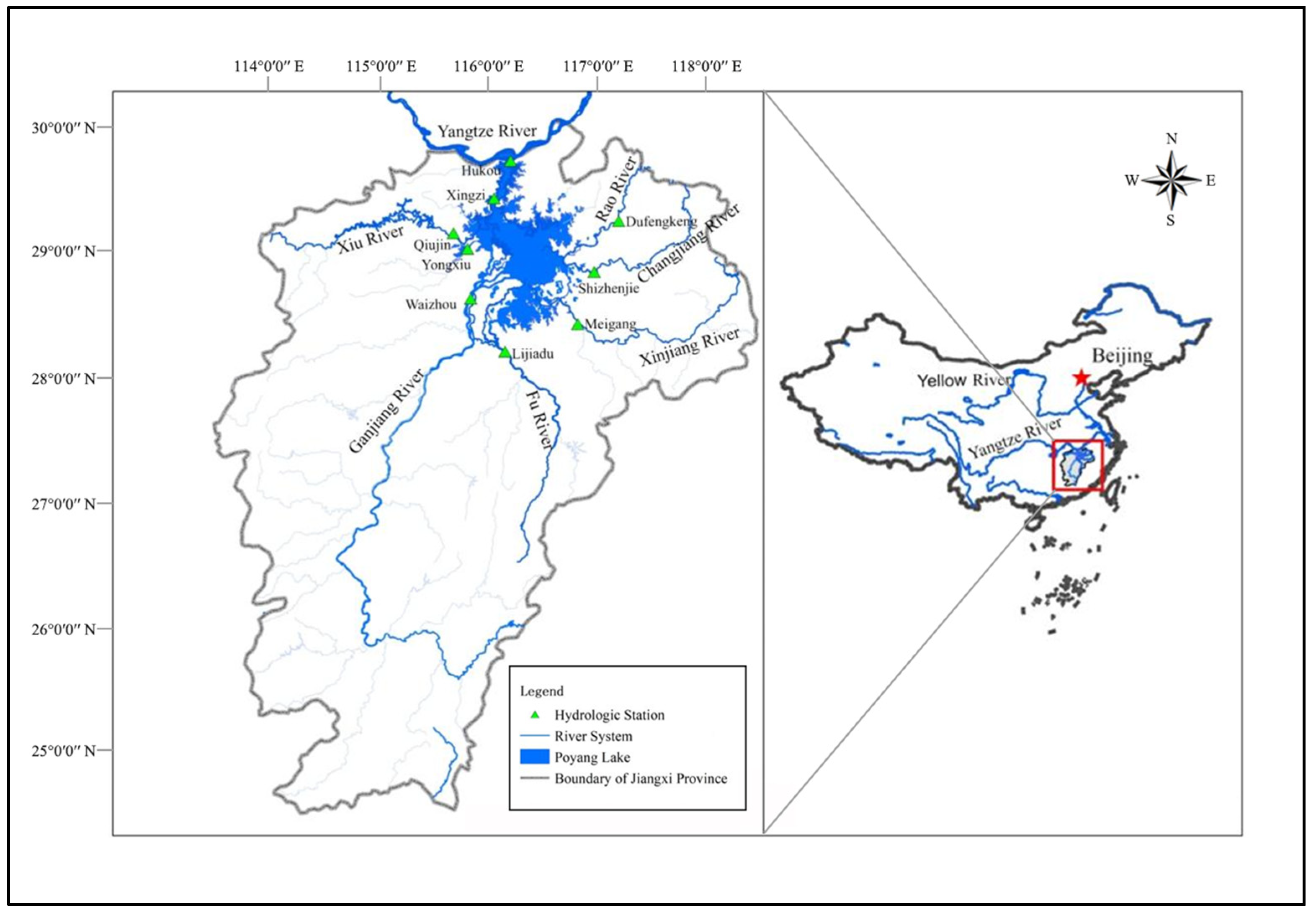

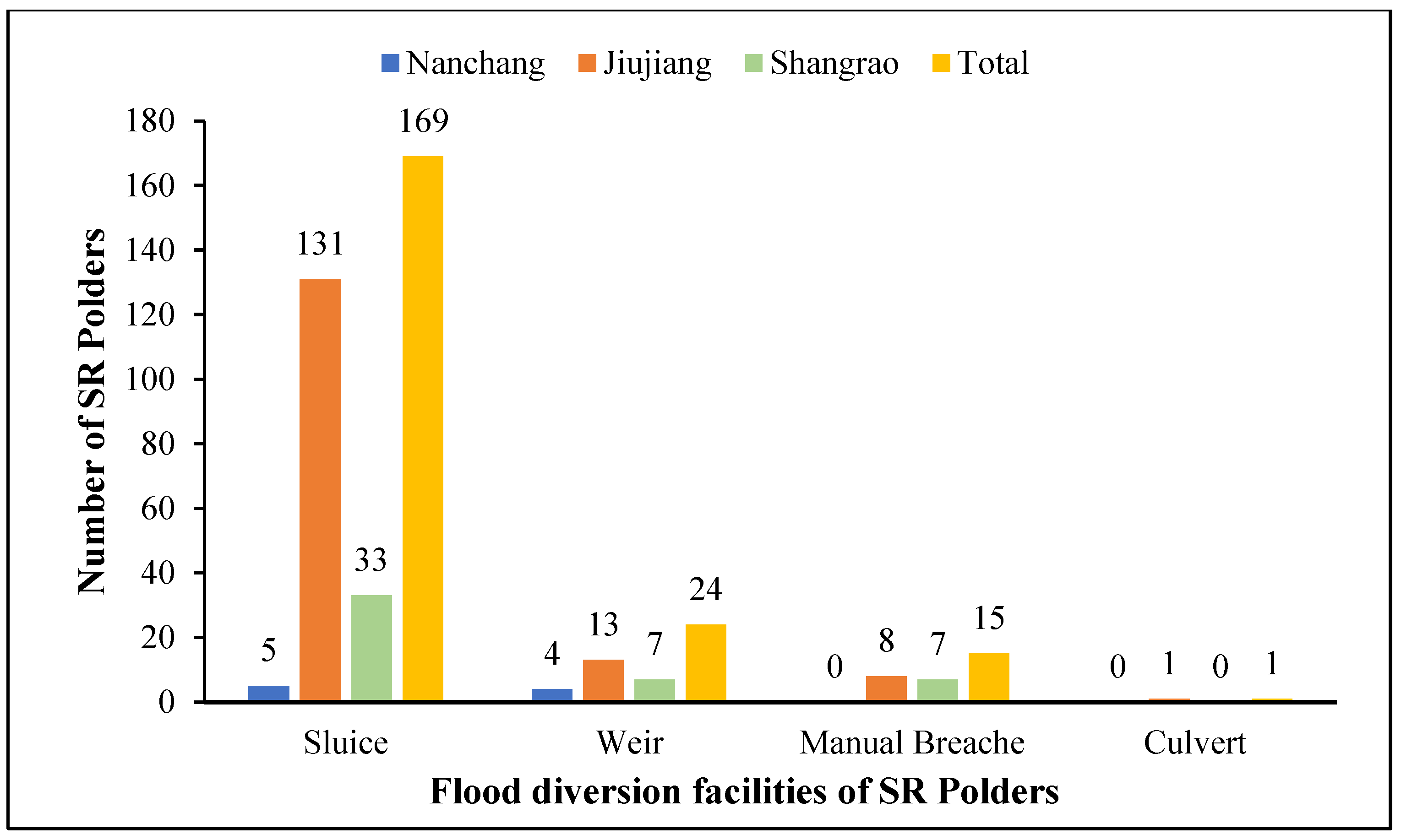
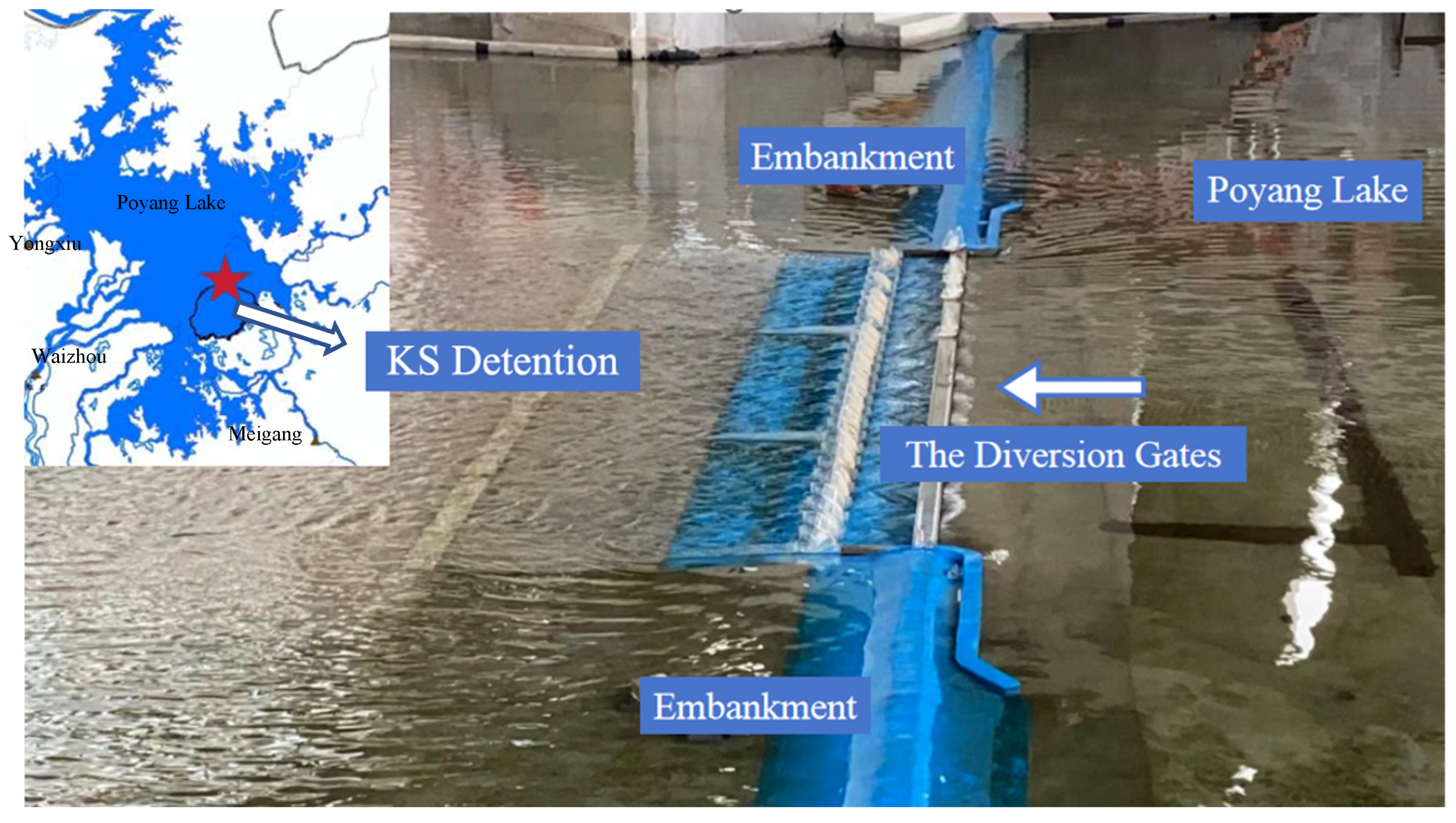
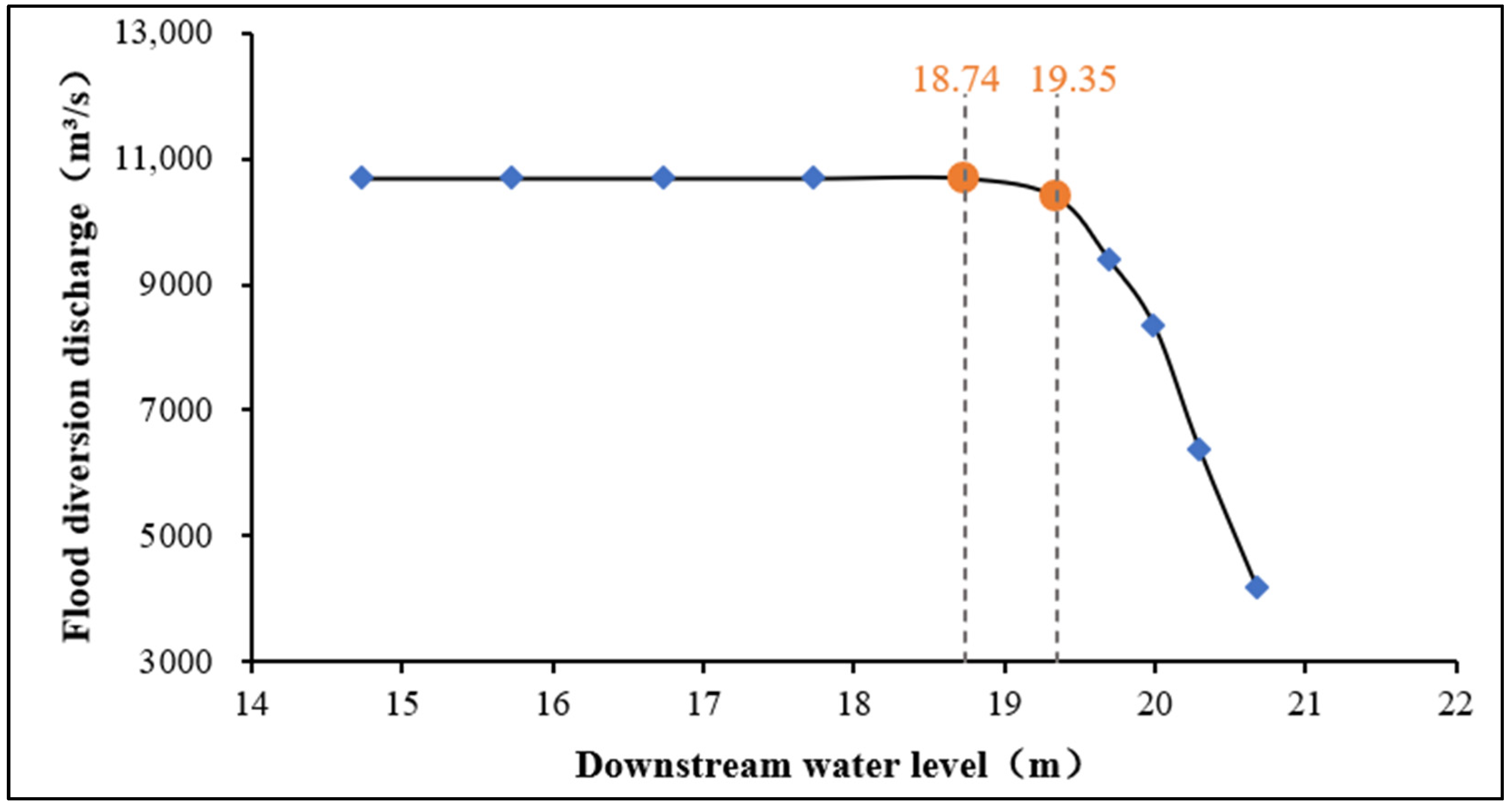
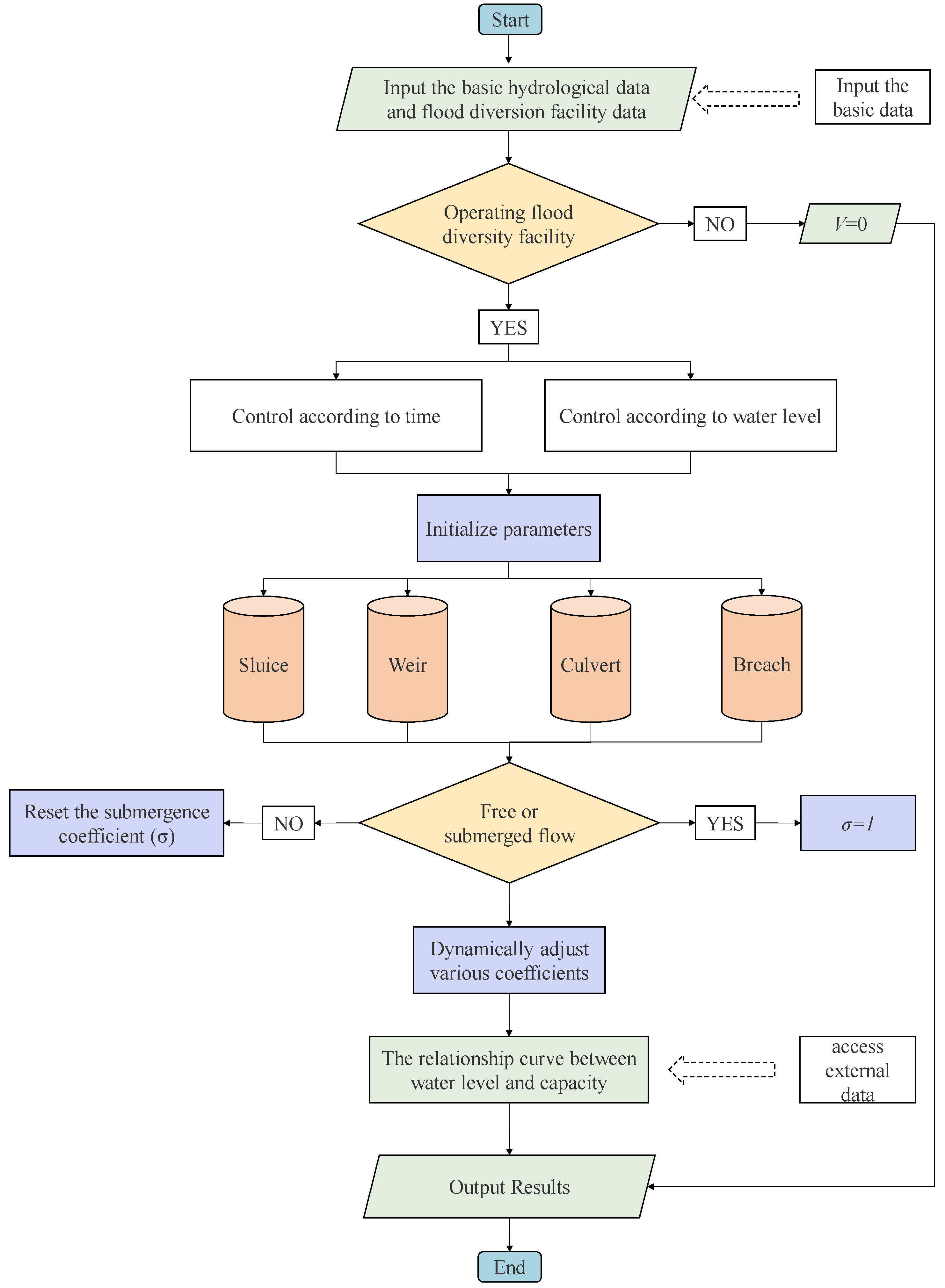

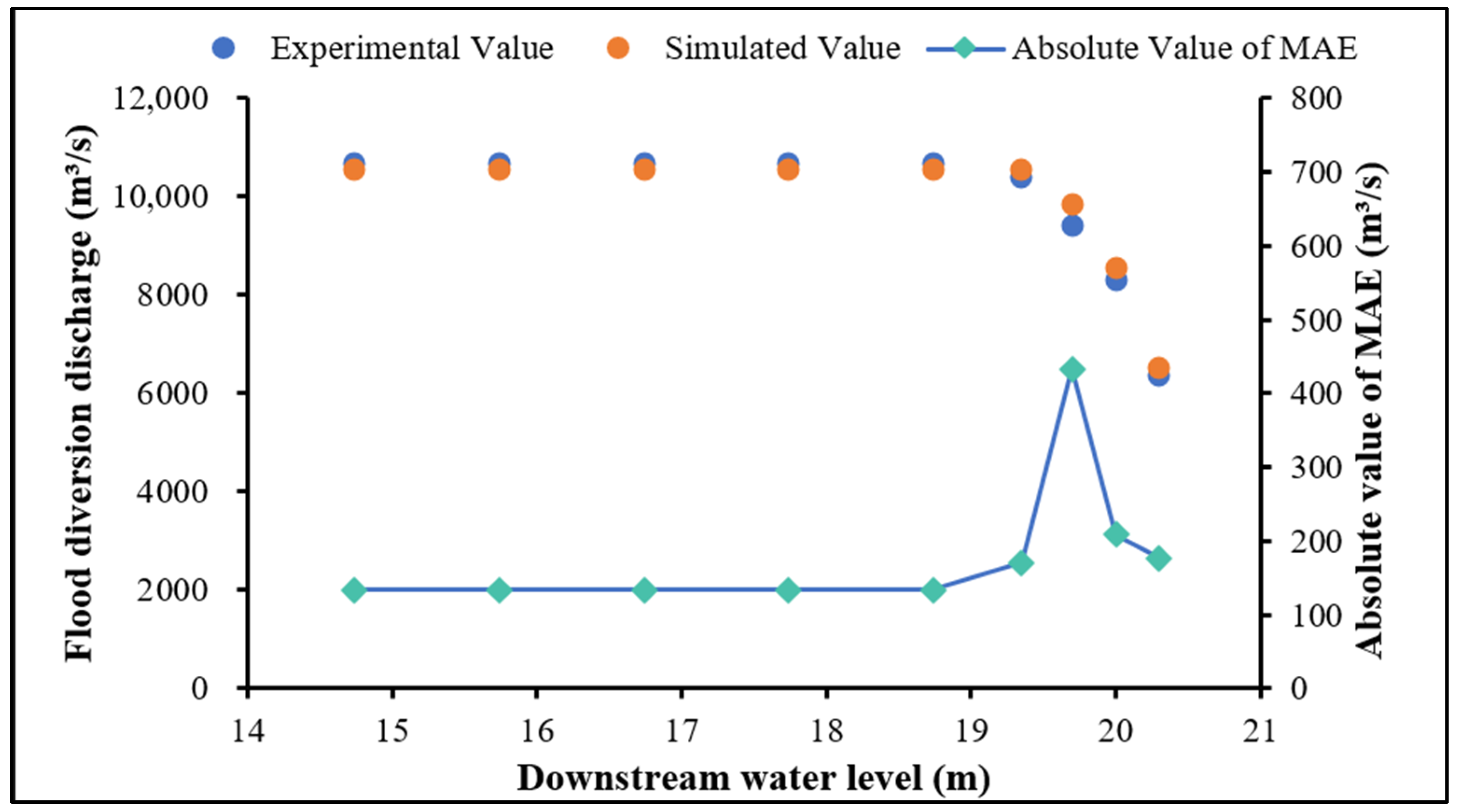

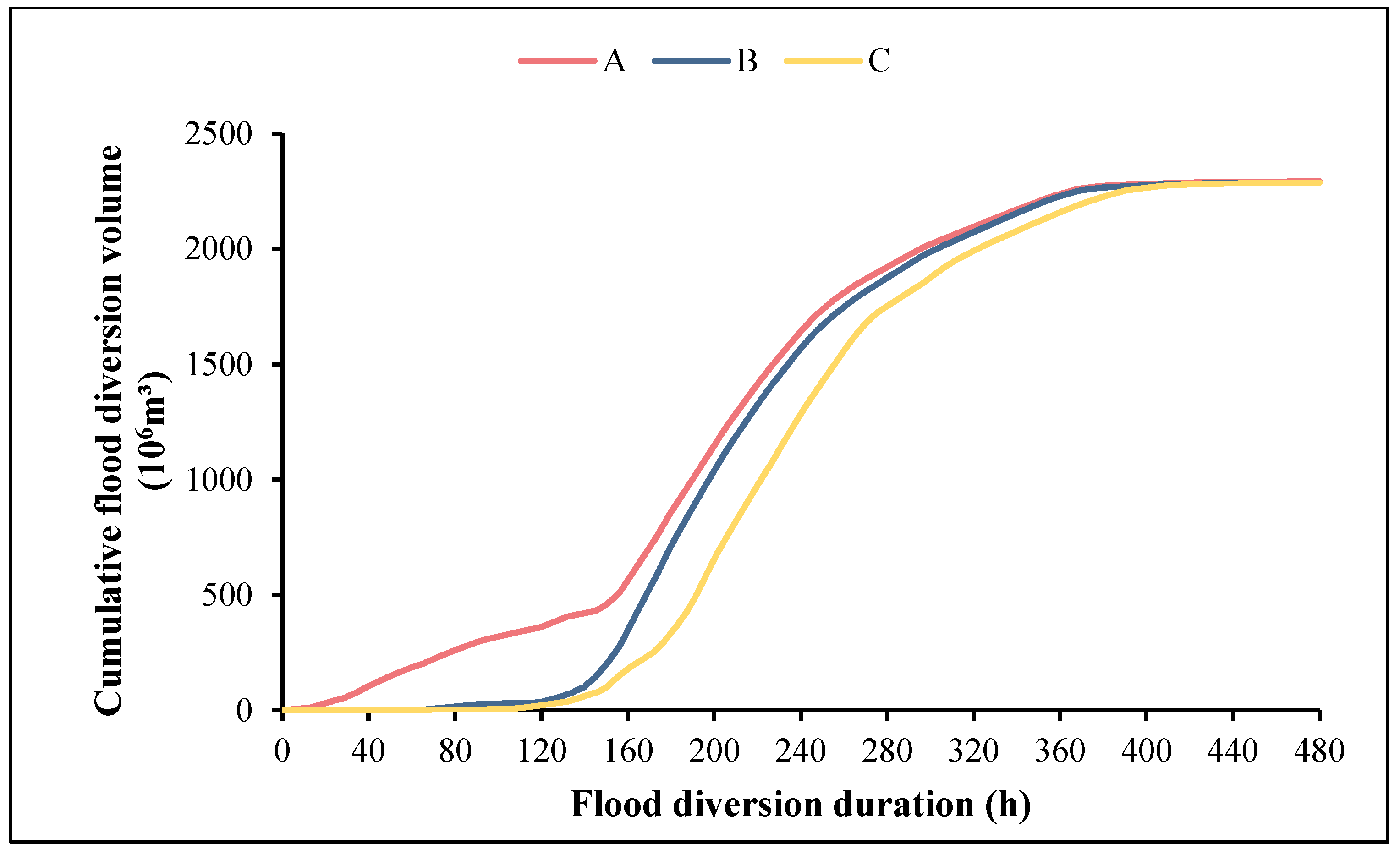
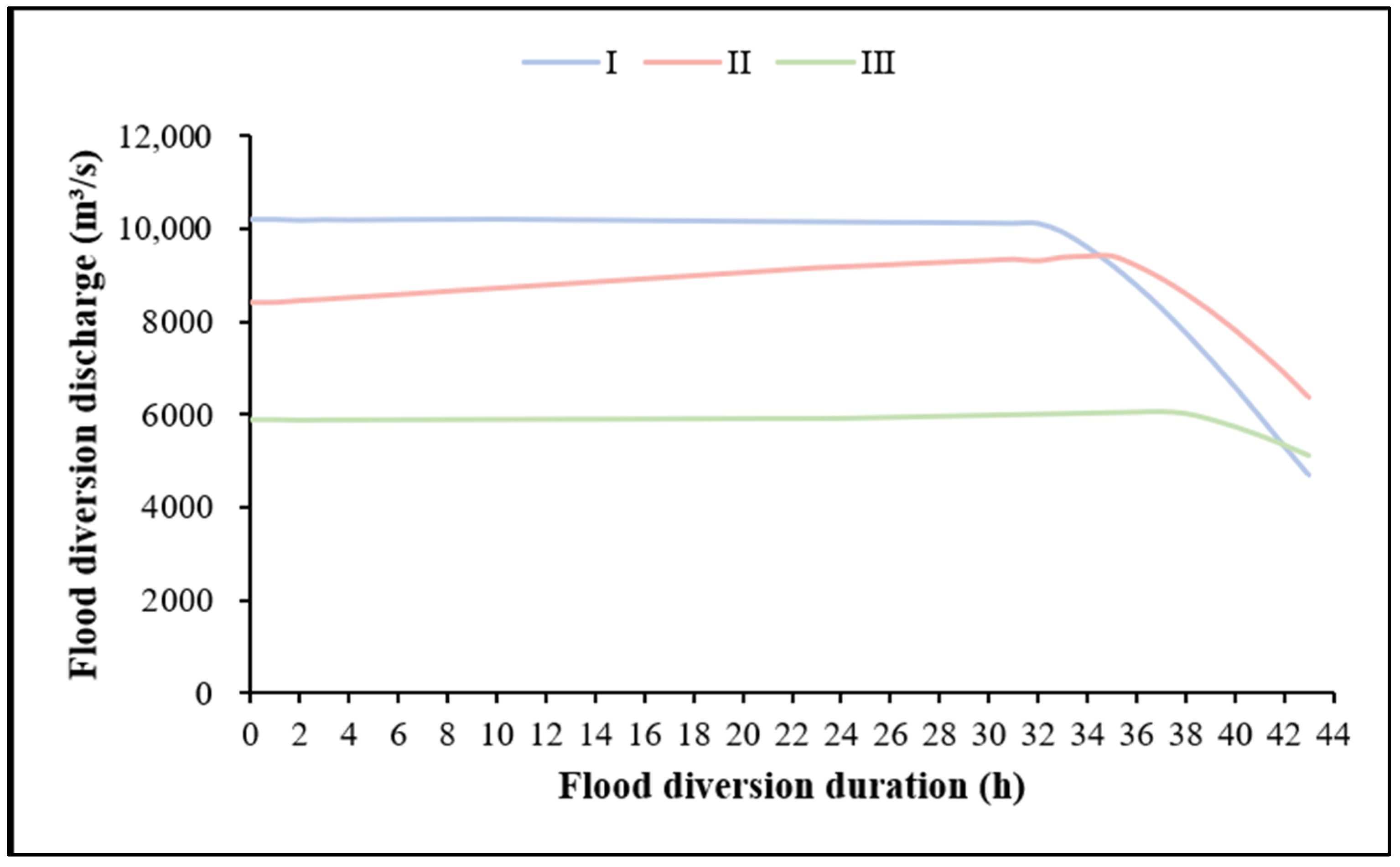
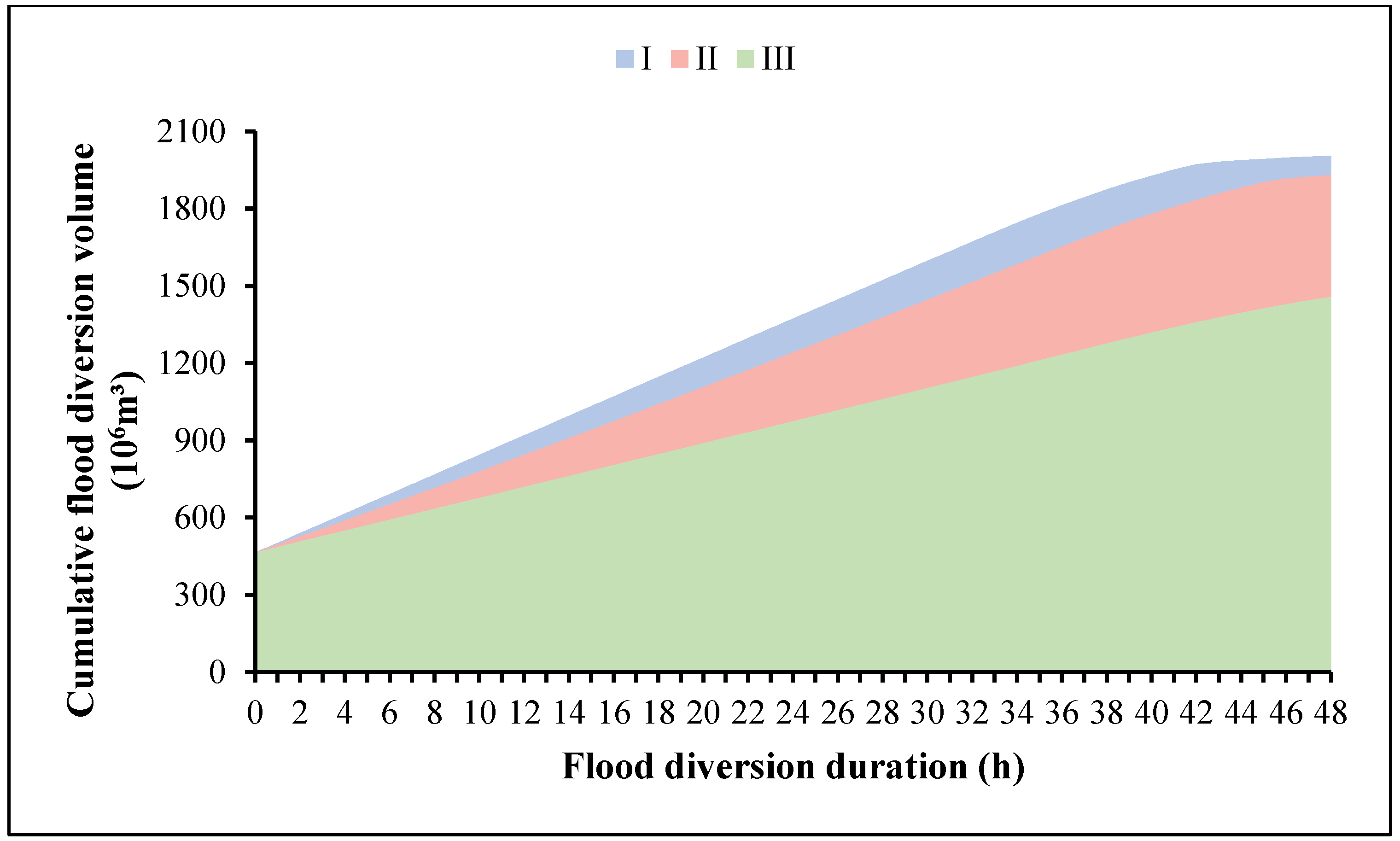
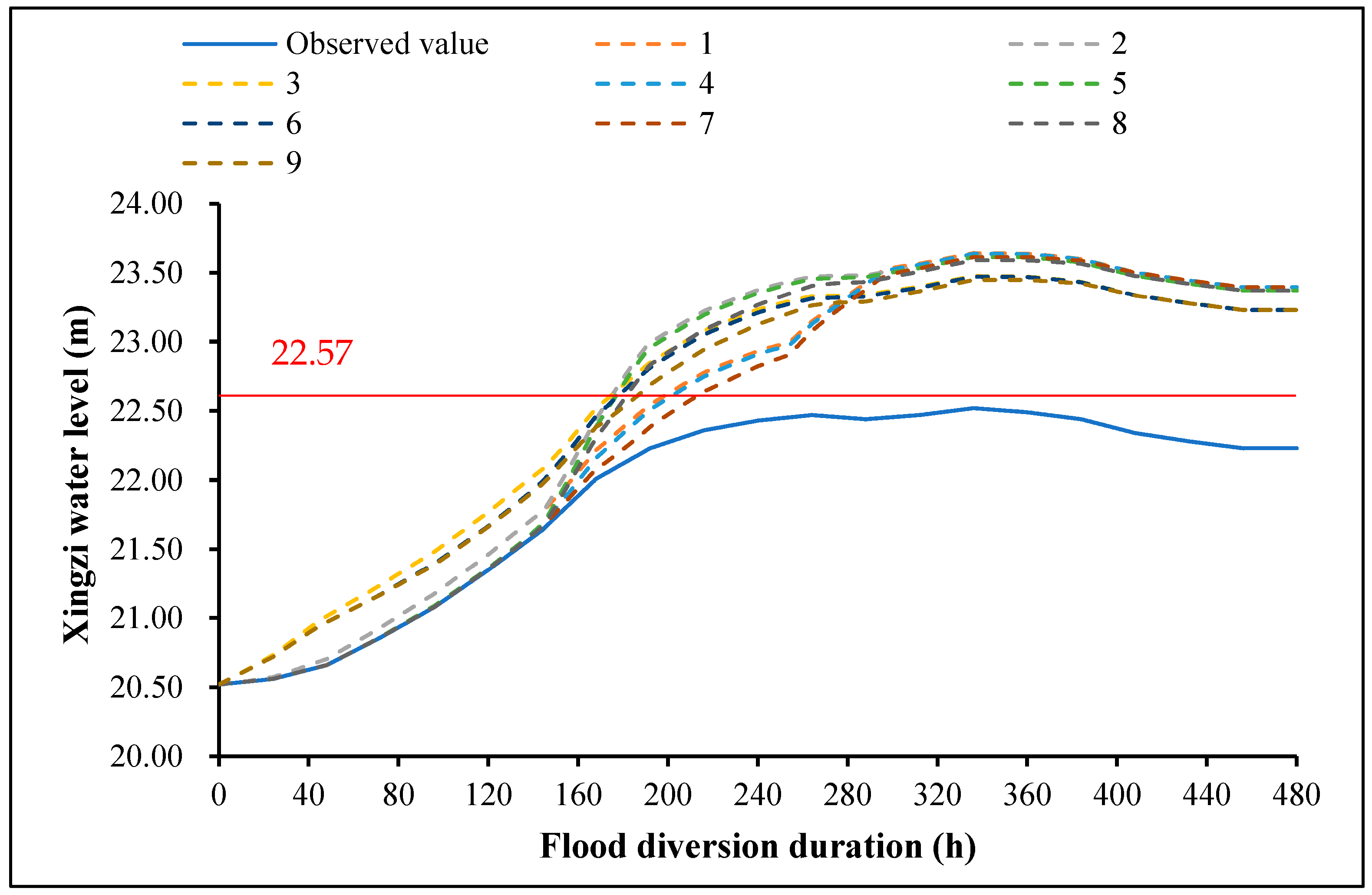
| Name | Type | Date of Operation | Flood Diversion Duration (h) | Cumulative Diversion Volume (108 m3) | The Absolute Value of Relative Errors (%) | ||
|---|---|---|---|---|---|---|---|
| Gate, Weir | Breaches | Diversion Duration | Diversion Volume | ||||
| Nanbei Port Polder | Survey results | 9 July | - | 216 | 1.78 | 1.85 | 1.12 |
| Simulated results | 9 July | - | 220 | 1.76 | |||
| Shuilanzhou Polder | Survey results | 9 July | - | 82 | 0.25 | 7.32 | 0 |
| Simulated results | 9 July | - | 76 | 0.25 | |||
| Lianbei Polder | Survey results | 9 July | 10 July, 12 July | 60 | 2.92 | 3.33 | 0.34 |
| Simulated results | 9 July | 10 July, 12 July | 58 | 2.91 | |||
| Liannan Polder | Survey results | 10 July | 11 July | 60 | 0.96 | 3.33 | 1.04 |
| Simulated results | 10 July | 11 July | 58 | 0.95 | |||
| Scheme Name | Hukou Water Level of Operating SR Polders/m | |
|---|---|---|
| SR Polders-I | SR Polders-II | |
| A | 20.50 | 21.68 |
| B | 21.50 | 21.68 |
| C | 21.65 | 22.05 |
| Scheme Name | Hukou Water Level of Operating KS Detention/m |
|---|---|
| I | 22.50 |
| II | 21.68 |
| III | 20.50 |
| Scheme Name | Hukou Water Level of Operating SR Polders/m | Hukou Water Level of Operating KS Detention/m | |
|---|---|---|---|
| SR Polders-I | SR Polders-II | ||
| 1 | 20.50 | 21.68 | 22.50 |
| 2 | 20.50 | 21.68 | 21.68 |
| 3 | 20.50 | 21.68 | 20.50 |
| 4 | 21.50 | 21.68 | 22.50 |
| 5 | 21.50 | 21.68 | 21.68 |
| 6 | 21.50 | 21.68 | 20.50 |
| 7 | 21.65 | 22.05 | 22.50 |
| 8 | 21.65 | 22.05 | 21.68 |
| 9 | 21.65 | 22.05 | 20.50 |
| Scheme Name | WL Reduction (m) | EL Duration (h) | FD Volume (104 m³) |
|---|---|---|---|
| 1 | 1.128 | 285 | 393,367 |
| 2 | 1.105 | 306 | 375,755 |
| 3 | 0.963 | 308 | 328,546 |
| 4 | 1.134 | 282 | 382,888 |
| 5 | 1.110 | 304 | 375,276 |
| 6 | 0.971 | 304 | 328,067 |
| 7 | 1.118 | 270 | 382,825 |
| 8 | 1.094 | 300 | 375,213 |
| 9 | 0.956 | 296 | 328,004 |
| Quantitative Target | RMD | Final Weight |
|---|---|---|
| WL Reduction | 1 | 0.402 |
| EL Duration | 0.818 | 0.329 |
| FD Volume | 0.667 | 0.269 |
| Scheme Name | 1 | 2 | 3 | 4 | 5 | 6 | 7 | 8 | 9 |
|---|---|---|---|---|---|---|---|---|---|
| 2.459 | 2.882 | 4.985 | 2.082 | 2.799 | 4.826 | 1.924 | 2.797 | 4.438 | |
| Optimal sequence | 3 | 6 | 9 | 2 | 5 | 8 | 1 | 4 | 7 |
Disclaimer/Publisher’s Note: The statements, opinions and data contained in all publications are solely those of the individual author(s) and contributor(s) and not of MDPI and/or the editor(s). MDPI and/or the editor(s) disclaim responsibility for any injury to people or property resulting from any ideas, methods, instructions or products referred to in the content. |
© 2025 by the authors. Licensee MDPI, Basel, Switzerland. This article is an open access article distributed under the terms and conditions of the Creative Commons Attribution (CC BY) license (https://creativecommons.org/licenses/by/4.0/).
Share and Cite
Deng, S.; Wang, Z.; Wu, L.; Wu, T.; Xia, Y.; Liu, Y. Research on Joint Operation of Flood Diversion and Storage Measures: A Case Study of Poyang Lake. Sustainability 2025, 17, 1522. https://doi.org/10.3390/su17041522
Deng S, Wang Z, Wu L, Wu T, Xia Y, Liu Y. Research on Joint Operation of Flood Diversion and Storage Measures: A Case Study of Poyang Lake. Sustainability. 2025; 17(4):1522. https://doi.org/10.3390/su17041522
Chicago/Turabian StyleDeng, Shupan, Zhichao Wang, Longhua Wu, Ting Wu, Yang Xia, and Yue Liu. 2025. "Research on Joint Operation of Flood Diversion and Storage Measures: A Case Study of Poyang Lake" Sustainability 17, no. 4: 1522. https://doi.org/10.3390/su17041522
APA StyleDeng, S., Wang, Z., Wu, L., Wu, T., Xia, Y., & Liu, Y. (2025). Research on Joint Operation of Flood Diversion and Storage Measures: A Case Study of Poyang Lake. Sustainability, 17(4), 1522. https://doi.org/10.3390/su17041522






